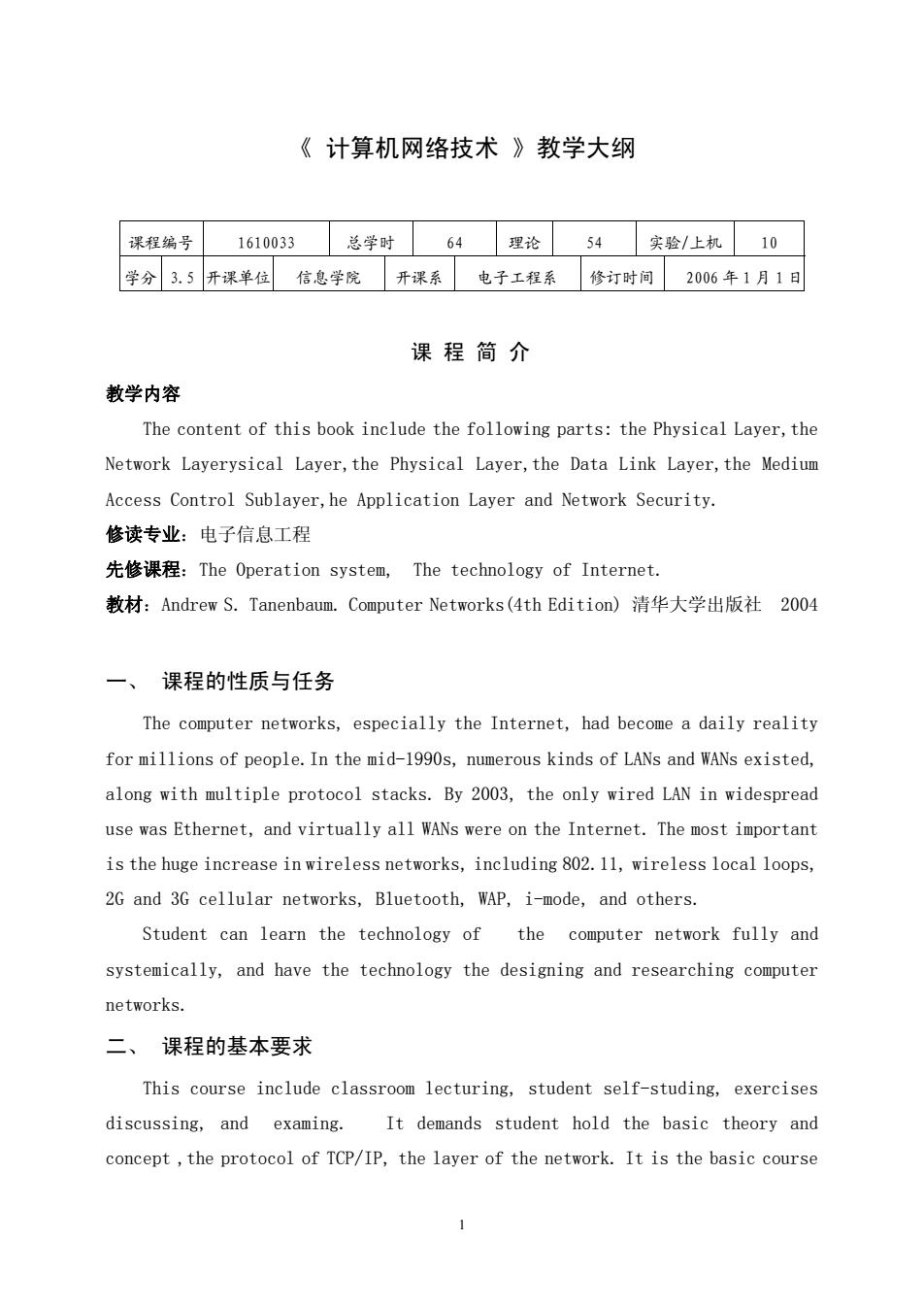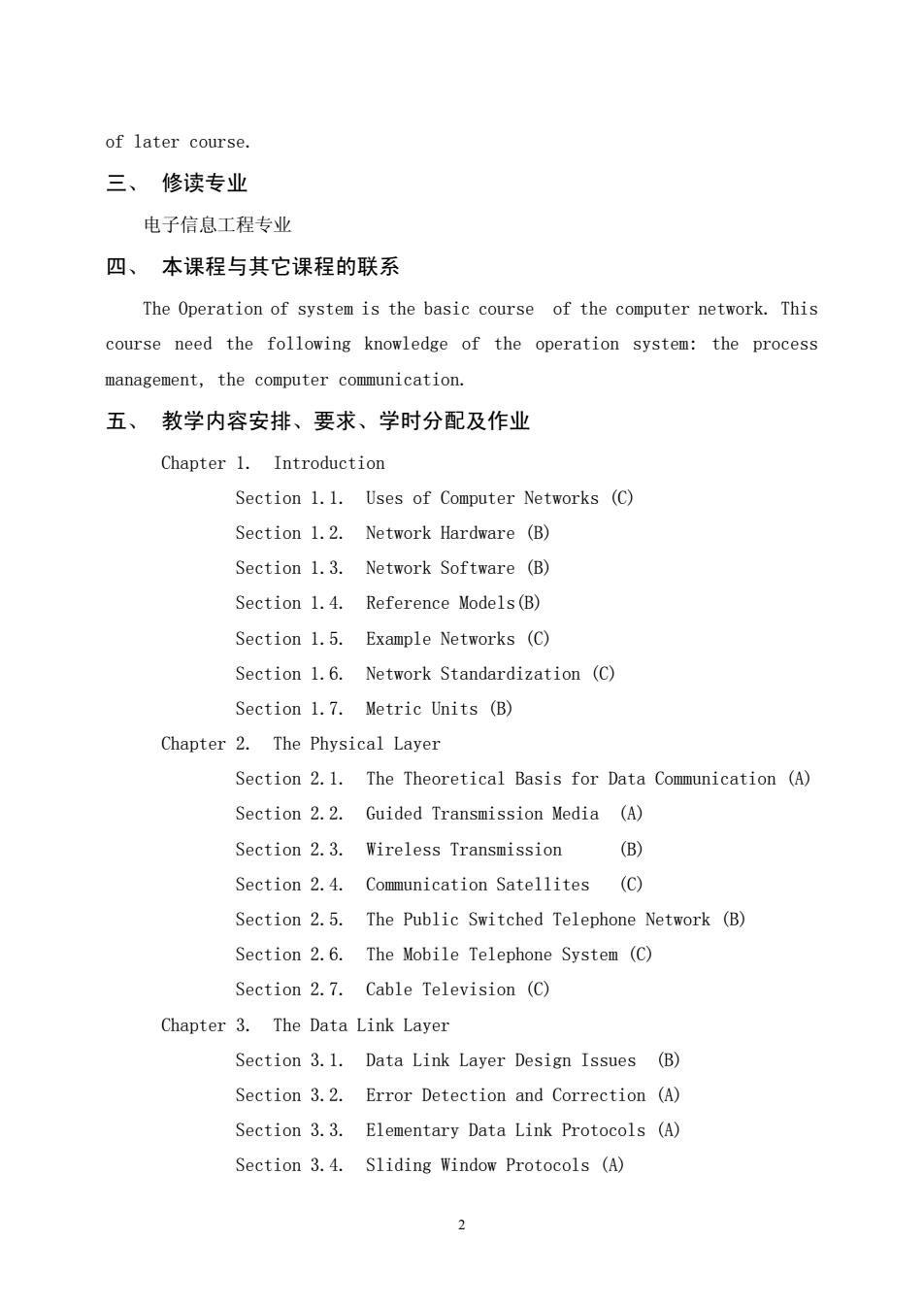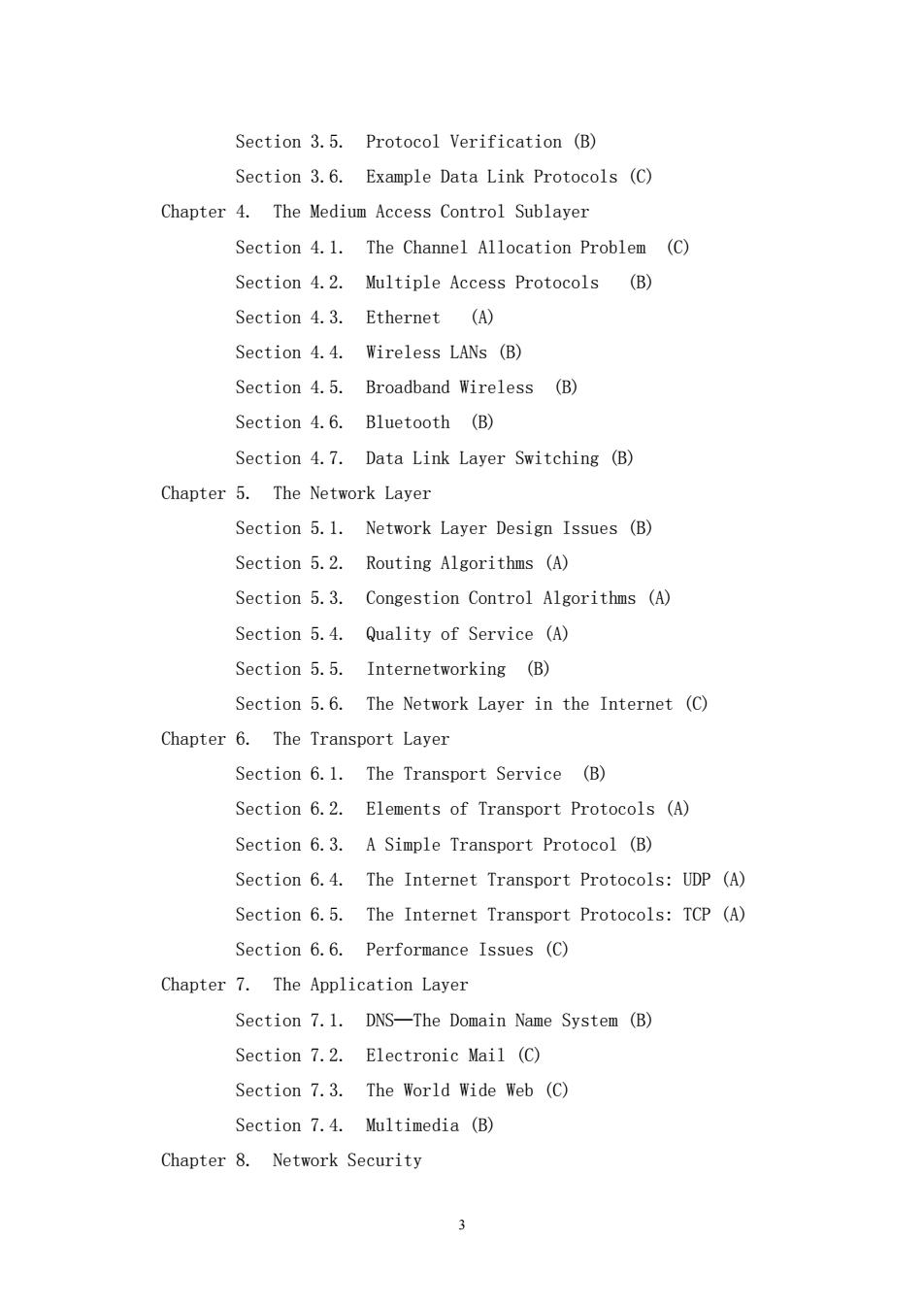
《计算机网络技术》教学大纲 课程编号 1610033总学时64理论54实验1上机10 学分3.5开课单位信息学院开课系电子工程系修订时间2006年1月1日 课程简介 教学内容 The content of this book include the following parts:the Physical Layer,the Network Layerysical Layer,the Physical Layer,the Data Link Layer,the Medium Access Control Sublayer,he Application Layer and Network Security. 修读专业:电子信息工程 先修课程:The Operation system,The technology of Internet. 教材:Andrew S.Tanenbaum..Computer Networks(4 th Edition)清华大学出版社2004 一、课程的性质与任务 The computer networks,especially the Internet,had become a daily reality for millions of people.In the mid-1990s,numerous kinds of LANs and WANs existed, along with multiple protocol stacks.By 2003,the only wired LAN in widespread use was Ethernet,and virtually all WANs were on the Internet.The most important is the huge increase in wireless networks,including 802.11,wireless local loops, 2G and 3G cellular networks,Bluetooth,WAP,i-mode,and others. Student can learn the technology of the computer network fully and systemically,and have the technology the designing and researching computer networks. 二、课程的基本要求 This course include classroom lecturing,student self-studing,exercises discussing,and examing.It demands student hold the basic theory and concept,the protocol of TCP/IP,the layer of the network.It is the basic course 1
《 计算机网络技术 》教学大纲 课程编号 1610033 总学时 64 理论 54 实验/上机 10 学分 3.5 开课单位 信息学院 开课系 电子工程系 修订时间 2006 年 1 月 1 日 课 程 简 介 教学内容 The content of this book include the following parts: the Physical Layer,the Network Layerysical Layer,the Physical Layer,the Data Link Layer,the Medium Access Control Sublayer,he Application Layer and Network Security. 修读专业:电子信息工程 先修课程:The Operation system, The technology of Internet. 教材:Andrew S. Tanenbaum. Computer Networks(4th Edition) 清华大学出版社 2004 一、 课程的性质与任务 The computer networks, especially the Internet, had become a daily reality for millions of people.In the mid-1990s, numerous kinds of LANs and WANs existed, along with multiple protocol stacks. By 2003, the only wired LAN in widespread use was Ethernet, and virtually all WANs were on the Internet. The most important is the huge increase in wireless networks, including 802.11, wireless local loops, 2G and 3G cellular networks, Bluetooth, WAP, i-mode, and others. Student can learn the technology of the computer network fully and systemically, and have the technology the designing and researching computer networks. 二、 课程的基本要求 This course include classroom lecturing, student self-studing, exercises discussing, and examing. It demands student hold the basic theory and concept ,the protocol of TCP/IP, the layer of the network. It is the basic course 1

of later course. 三、修读专业 电子信息工程专业 四、本课程与其它课程的联系 The Operation of system is the basic course of the computer network.This course need the following knowledge of the operation system:the process management,the computer communication. 五、教学内容安排、要求、学时分配及作业 Chapter 1.Introduction Section 1.1.Uses of Computer Networks (C) Section 1.2.Network Hardware (B) Section 1.3.Network Software (B) Section 1.4.Reference Models(B) Section 1.5.Example Networks (C) Section 1.6.Network Standardization (C) Section 1.7.Metric Units (B) Chapter 2.The Physical Layer Section 2.1.The Theoretical Basis for Data Communication (A) Section 2.2.Guided Transmission Media (A) Section 2.3.Wireless Transmission (B) Section 2.4.Communication Satellites (C) Section 2.5.The Public Switched Telephone Network (B) Section 2.6.The Mobile Telephone System (C) Section 2.7.Cable Television (C) Chapter 3.The Data Link Layer Section 3.1.Data Link Layer Design Issues (B) Section 3.2.Error Detection and Correction (A) Section 3.3.Elementary Data Link Protocols (A) Section 3.4.Sliding Window Protocols (A) 2
of later course. 三、 修读专业 电子信息工程专业 四、 本课程与其它课程的联系 The Operation of system is the basic course of the computer network. This course need the following knowledge of the operation system: the process management, the computer communication. 五、 教学内容安排、要求、学时分配及作业 Chapter 1. Introduction Section 1.1. Uses of Computer Networks (C) Section 1.2. Network Hardware (B) Section 1.3. Network Software (B) Section 1.4. Reference Models(B) Section 1.5. Example Networks (C) Section 1.6. Network Standardization (C) Section 1.7. Metric Units (B) Chapter 2. The Physical Layer Section 2.1. The Theoretical Basis for Data Communication (A) Section 2.2. Guided Transmission Media (A) Section 2.3. Wireless Transmission (B) Section 2.4. Communication Satellites (C) Section 2.5. The Public Switched Telephone Network (B) Section 2.6. The Mobile Telephone System (C) Section 2.7. Cable Television (C) Chapter 3. The Data Link Layer Section 3.1. Data Link Layer Design Issues (B) Section 3.2. Error Detection and Correction (A) Section 3.3. Elementary Data Link Protocols (A) Section 3.4. Sliding Window Protocols (A) 2

Section 3.5.Protocol Verification (B) Section 3.6.Example Data Link Protocols (C) Chapter 4.The Medium Access Control Sublayer Section 4.1.The Channel Allocation Problem (C) Section 4.2.Multiple Access Protocols (B) Section 4.3.Ethernet (A) Section 4.4.Wireless LANs (B) Section 4.5.Broadband Wireless (B) Section 4.6.Bluetooth (B) Section 4.7.Data Link Layer Switching (B) Chapter 5.The Network Layer Section 5.1.Network Layer Design Issues (B) Section 5.2.Routing Algorithms (A) Section 5.3.Congestion Control Algorithms (A) Section 5.4.Quality of Service (A) Section 5.5.Internetworking (B) Section 5.6.The Network Layer in the Internet (C) Chapter 6.The Transport Layer Section 6.1.The Transport Service (B) Section 6.2.Elements of Transport Protocols (A) Section 6.3.A Simple Transport Protocol (B) Section 6.4.The Internet Transport Protocols:UDP (A) Section 6.5.The Internet Transport Protocols:TCP (A) Section 6.6.Performance Issues (C) Chapter 7.The Application Layer Section 7.1.DNS-The Domain Name System (B) Section 7.2.Electronic Mail (C) Section 7.3.The World Wide Web (C) Section 7.4.Multimedia (B) Chapter 8.Network Security 2
Section 3.5. Protocol Verification (B) Section 3.6. Example Data Link Protocols (C) Chapter 4. The Medium Access Control Sublayer Section 4.1. The Channel Allocation Problem (C) Section 4.2. Multiple Access Protocols (B) Section 4.3. Ethernet (A) Section 4.4. Wireless LANs (B) Section 4.5. Broadband Wireless (B) Section 4.6. Bluetooth (B) Section 4.7. Data Link Layer Switching (B) Chapter 5. The Network Layer Section 5.1. Network Layer Design Issues (B) Section 5.2. Routing Algorithms (A) Section 5.3. Congestion Control Algorithms (A) Section 5.4. Quality of Service (A) Section 5.5. Internetworking (B) Section 5.6. The Network Layer in the Internet (C) Chapter 6. The Transport Layer Section 6.1. The Transport Service (B) Section 6.2. Elements of Transport Protocols (A) Section 6.3. A Simple Transport Protocol (B) Section 6.4. The Internet Transport Protocols: UDP (A) Section 6.5. The Internet Transport Protocols: TCP (A) Section 6.6. Performance Issues (C) Chapter 7. The Application Layer Section 7.1. DNS—The Domain Name System (B) Section 7.2. Electronic Mail (C) Section 7.3. The World Wide Web (C) Section 7.4. Multimedia (B) Chapter 8. Network Security 3

Section 8.1.Cryptography (B) Section 8.2.Symmetric-Key Algorithms (B) Section 8.3.Public-Key Algorithms (A) Section 8.4.Digital Signatures (B) Section 8.5.Management of Public Keys (B) Section 8.6.Communication Security (A) Section 8.7.Authentication Protocols (C) Section 8.8.E-Mail Security (C) Section 8.9.Web Security (C) 六、实验内容与要求 序号 实验内容 学时 1双绞线线缆的制作 2 2对等网配置及网络资源共享 2 安装和配置DNS服务器 4 IIS(WEB、FTP)服务器建立、管理和使用 2 5安装与设置DHCP服务器 2 七、教材与参考书 本课程选用教材: Andrew S.Tanenbaum.Computer Networks(4 th Edition)清华大学出版社2O04 本课程推荐参考书: 谢希仁计算机网络(第4版)电子工业出版社2005 执笔:甘元驹 审核: 批准人: 时间:2006.1.1 4 信息与通信类课程组 甘元响 郑小平 梁能
Section 8.1. Cryptography (B) Section 8.2. Symmetric-Key Algorithms (B) Section 8.3. Public-Key Algorithms (A) Section 8.4. Digital Signatures (B) Section 8.5. Management of Public Keys (B) Section 8.6. Communication Security (A) Section 8.7. Authentication Protocols (C) Section 8.8. E-Mail Security (C) Section 8.9. Web Security (C) 六、 实验内容与要求 序号 实验内容 学时 1 双绞线线缆的制作 2 2 对等网配置及网络资源共享 2 3 安装和配置 DNS 服务器 2 4 IIS(WEB、FTP)服务器建立、管理和使用 2 5 安装与设置 DHCP 服务器 2 七、 教材与参考书 本课程选用教材: Andrew S. Tanenbaum. Computer Networks(4th Edition) 清华大学出版社 2004 本课程推荐参考书: 谢希仁 计算机网络(第 4 版) 电子工业出版社 2005 执笔:甘元驹 审核: 批准人: 时间:2006.1.1 4 信息与通信类课程组 甘元驹 郑小平 梁能